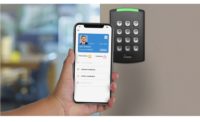The access control industry is not known for its lightning speed adoption of new technology. How many years were “smart cards” and biometrics just around the corner? Still, despite the average life cycle of an access credential still hovering at 15-20 years, there are compelling reasons for end users today to incorporate some of the latest technology offerings, not least of which is the increasing speed of technology advancement overall. One credential technology that is particularly getting a lot of buzz at tradeshows and in future-proofing planning meetings is the mobile credential.
As the smartphone has become ubiquitous in today’s society, the desire to “bring your own device” to work and use it for everything is strong — particularly with the up-and-coming millennial workforce. As they use the smartphone for literally everything else, the concept of a card with 20-year-old technology on it is anathema to these employees. Similarly, an executive at a corporate facility may wonder why her credential to get into the office is so far behind what she uses at her smart home.
So just how far along the adoption curve are mobile credentials right now, and — more importantly — why should you be pushing the benefits of these credentials to your customer? SDM spoke with Steve Van Till, co-founder, president and CEO for Brivo, Bethesda, Md., to find out.
SDM: How prevalent are mobile credentials today and how many dealers and integrators do you see incorporating these into their customer’s access control solutions?
Van Till: Having only been introduced in the past four years, mobile credentials are still in the early phase of their life cycle with overall adoption currently at around 25 percent. Our dealers and integrators are tracking at current industry adoption rates, but it’s worth pointing out that at this stage of the life cycle, dealer and end-user education is very important in successfully transitioning from selling legacy systems to cloud-enabled mobile solutions. With the growing deployment of Bluetooth Low Energy (BLE) readers, mobile credentials are able to support additional entryways, which should also accelerate growth along with the removal of other barriers to growth.
SDM: What is the biggest advantage to the integrator in offering mobile credential solutions? What kind of RMR might it provide them?
Van Till: The top two benefits cited by our integrators and dealers are meeting customer needs and use cases in the BYOD world of today, and leading with more secure technology options.
For the security dealer or integrator, selling mobile credentials — which require little to no installation support — can be very profitable in building their RMR. Many of our dealers are selling mobile credentials for “mobile first” customers or as an add-on for customers as part of a phased migration path from legacy credentials.
SDM: How do mobile credentials help dealers or integrators improve their customer’s security posture?
Van Till: Organizations using traditional access cards such as proximity cards expose themselves to security risks such as lost cards, copying and cloning. Newer encrypted smart cards are more secure, but not as secure as mobile credentials, which by default include dual-factor authentication through pins/passwords and are less likely to be lost or stolen. As a more secure dual-factor authentication solution, we are now seeing even more reliable smartphone-equipped biometric capabilities that can be integrated with access control systems.
SDM: What types of customers are most likely to be interested in a mobile credential right now? How are they typically using them?
Van Till: Some early adopter segments include senior living, shared offices, fitness centers, higher education, multi-location, and multi-family properties. Many of these segments utilize mobile credentials as their primary credential or as part of a broader BYOD program. Benefits sighted by customers from these segments include convenience, ease-of-use and management, increased security, productivity gains, and expense reduction. We are also seeing widespread use by employees across all levels in the organization as well as for issuing temporary passes to visitors, contractors, and for use by tenants in multi-family residential properties.
SDM: What are the latest offerings from Brivo in mobile credentials?
Van Till: Brivo recently introduced two new features to our Brivo Onair Pass mobile credential including a button that automatically opens the closest door authorized for each user; and integrated embedded smartphone biometric authentication supporting fingerprint, facial recognition, and IOS voice recognition to protect high security areas.
SDM: What advice would you give to dealers or integrators about specifying, selling and managing mobile credential solutions?
Steve Van Till: I would say focus on understanding your customer’s applications in relation to the benefits of mobile credentials that address these key priorities and support financial justification for gaining project approval.






